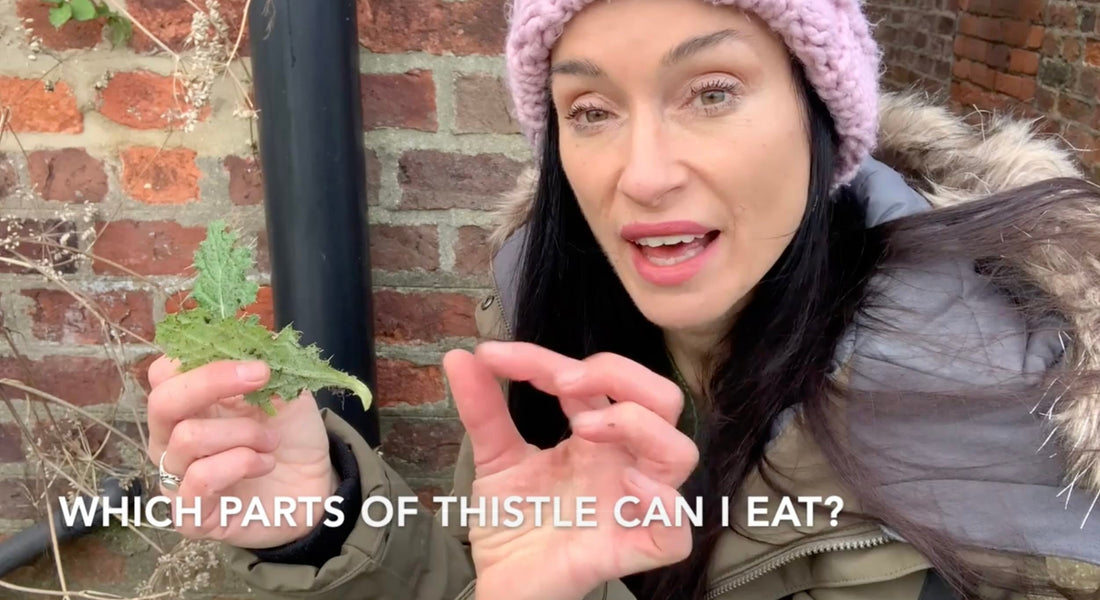
I can eat thistle?
I can really eat thistles?! But what about the spikes?
You may be suprised to hear.... yes you can! Read on to discover how...
Firstly, Where does Thistle Get Its' Name?
The word Thistle comes from old English 'Thist-el' meaning 'to prick'. There are at least 14 different types of thistle in the UK, but all are edible so identification errors are not a concern.
Habitat and Seasonality of Thistle.
Thistle is a good one for foragers as it is easy to identify, but also that it grows everywhere, urban areas, commercial, rural... and also that all livestock have to leave it alone thanks to it's ability to prick. We have one advantage over our animal competitors with this plant and that is the ability to use scissors. Thistle is also available not only geographically easily but time-wise - growing above ground for much of the year giving foragers year round sustenance.
LEARN TO FORAGE WITH ME IN MY ONLINE COURSE HEREWhich Parts of the Plant Can I Use?
You can eat all parts of thistle - root, stem, leaves, flowers, seeds. My boys used to enjoy taking a tall thistle, and with their pen knives on a walk, they would strip it down to just the stem. You can then choose to peel the skin of the stem or eat it as is. My boys would chomp on this refreshing watery bitter bite until they learned they could take it home and dip it in sugar, akin to rhubarb stems in sugar, other ways you can use the stem as an adult is to chop it into inch long pieces and add to salads as a fresh watery, bitter crunch, or add the inch long pieces of stem to a stir fry, braising them in soy sauce and oil. I have done beach meals of foraged limpet stir fried with thistle stem in this way and the stem absorbs nicely the taste of the seafood. Or, how about dipping the sticks of stem into batter, then deep frying and dipping in a sauce? When you think some summer thistles can grow to five or six feet high (in the moorland dale where I used to live the Summer Show had a competition category for the resident that could grow the tallest thistle - many were coming in at six feet). Thats a lot of stem!

The roots of thistle are notorious at snapping when you pull them out the ground this is one of their reproduction methods, it ensures they come back next year... so when you tug out a thistle, just know that the most chunky part of the root will remain behind, if you want all of the root it may therefore be worth taking a small trowel with you for harvesting.
What to do with the roots? I have been known to eat them covered with earth, raw, just pulled out the ground. The skin of the root like this is not unlike sweet potato skin in taste, the inner part of the root is tougher and would therefore benefit from cooking or grating into coleslaw. You can either again stir fry the thistle root, or boil it up in a stock. Remember the most starch rich parts of a plant are the roots and central stem where the sugars are so if sustenance is your need, aim to get used to eating the roots and central stems of edible plants.
Leaves can be eaten, simply take a pair of scissors and cut around the leaf cutting off the spikes, then cut out the central vein with a steep 'v' shaped cut. The veins are more bitter and tough to eat.
Some thistle types have more leaf than spike but some varieties seem to have more spike than leaf. For eating thistle therefore I would choose a variety like spear or marsh thistle that have big dark leaves with only a few spikes. Here is a photo of spear thistle

Traditional Recipes
- Cook the leaves and peeled stems well until soft (after spikes and veins cut out) like cabbage in salty water. Serve with a knob of butter, or why not cream them by blitzing the boiled thistle and serving on mashed potato?
- Pull apart the purple flowers and add to almond shortbread mix. Bake and serve decorated towards the end of baking with petals pressed in to the surface. Cont. below...
Modern Recipes
- Blitz a couple of raw leaves into a super green smoothie.
- Pull open the flower head and get to the 'button' - the solid bit at the base. Dip in batter and fry. Serve savoury or sweet.
- Mix the above greens and mashed potato with cheese and fry dollops as 'bubble and squeak'.
Health Benefits
Thistle like most wild plants is higher in minerals than supermarket veg. Minerals present in thistle are iron, potassium, and silica. Exact percentages of minerals and vitamins found on the internet are always dependent on the habitat, climate and other variables - no two plants can be said to have a set amount of minerals or vitamins. On the whole we know wild plants tend to have higher levels than our supermarket veg. due to being grown in un-farmed soil and having deeper roots to draw up more minerals. With this in mind, here is a link to a full list of vitamins and minerals found in thistle.
Link to article on vitamins and minerals in thistle
Cautions
Thistlex is a herbicide used by farmers - to kill thistle, ensure the field you get your thistle from hasn't been sprayed. Tell tale signs are pale and slightly droopy plants. Thistlex is usually applied early March until late October and farmers using Thistlex are told it is safe to graze animals on a sprayed field seven days after application. I would still exercise caution and forage thistle from woodland or intake land (higher up areas where farm land meets moor).
Another caution is to remember that there are 14 types of thistle some of the varieties belong to different plant families and one of these plant families is the 'daisy family'. (inc. dandelions, daisies). Some people experience an allergic reaction to daisy family members. Check first that either the thistle type you choose is not a daisy plant member if the person you feed is allergic to daisy family plants.
Always check with your gp if you are:
- On medication
- Pregnant
- Breast feeding.
Taste.
I describe the taste of the root as bland slightly sweet, the stem as fresh and bitter (far nicer than burdock stem which I find way too astringent), leaves are more bland than the stem, this is because usually plants with spikes don't also need a strong taste to deter predators.
Lookalikes
Some plants that look like thistle are sonchus (sow thistle), these tend to not have as vicious looking spikes and have yellow flowers rather than the common pinky purple of thistle. I have included a photo of prickly sow thistle (credit to NatureSpot) here (though again there are several species of sonchus).
Sonchus:






